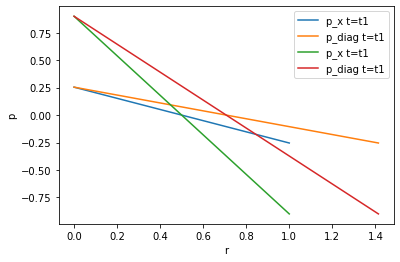1. reading a single VTU file
A single VTU file can be accessed via:
import vtuIO
vtufile = vtuIO.VTUIO("examples/square_1e2_pcs_0_ts_1_t_1.000000.vtu", dim=2)
The dim argument is needed for correct interpolation. By defualt dim=3 is assumed.
Basic VTU properties, like fieldnames, points and corresponding fielddata as provided by the unstructured grid VTK class can be simply accessed as follows:
vtufile.get_point_field_names()
['D1_left_bottom_N1_right', 'Linear_1_to_minus1', 'pressure', 'v']
points (in this example the first 3 points) can be simmply accessed with
vtufile.points[0:3]
array([[0. , 0. ],
[0.1, 0. ],
[0.2, 0. ]])
vtufile.get_point_field("v")[0:3]
array([[ 2.00000000e+00, 0.00000000e+00],
[ 2.00000000e+00, 1.62547932e-16],
[ 2.00000000e+00, -9.91229679e-16]])
Aside basic VTU properties, the field data at any given point, e.g,
points={'pt0': (0.5,0.5,0.0), 'pt1': (0.2,0.2,0.0)}
can be retrieved via
vtufile.get_point_data("pressure", pts=points)
{'pt0': 3.413510714673346e-17, 'pt1': 0.6000000000000001}
1.1 Creating contour plots
import matplotlib.pyplot as plt
import matplotlib.tri as tri
vtufile = vtuIO.VTUIO("examples/square2d_random.vtu", dim=2)
field = vtufile.get_point_field("gaussian_field_2");
triang = tri.Triangulation(vtufile.points[:,0], vtufile.points[:,1])
plt.tricontourf(triang,field)
<matplotlib.tri.tricontour.TriContourSet at 0x7f81305deac0>

This random field was created using the ranmedi package: https://github.com/joergbuchwald/ranmedi/
1.2 Extracting Pointsetdata
There are basically three interpolation methods available for extracting data at arbitrary points (cubic is only available for 1D and 2D). The default is linear.
methods = ["nearest", "linear", "cubic"]
import numpy as np
x = np.linspace(0.0,64,num=100);
diagonal = [(i,i,0) for i in x];
vtufile = vtuIO.VTUIO("examples/square2d_random.vtu", dim=2)
data_diag = {}
for method in methods:
data_diag[method] = vtufile.get_point_set_data("gaussian_field_2", pointsetarray=diagonal, interpolation_method=method)
r_diag = np.sqrt(2*x*x)
for method in methods:
plt.plot(r_diag, data_diag[method], label=method)
plt.legend()
<matplotlib.legend.Legend at 0x7f81302c1e80>

2. Writing VTU files
some simple methods also exist for adding new fields to an existing VTU file or save it separately:
vtufile = vtuIO.VTUIO("examples/square_1e2_pcs_0_ts_1_t_1.000000.vtu", dim=2)
p_size = len(vtufile.get_point_field("pressure"))
p0 = np.ones(p_size) * 1e6
vtufile.write_field(p0, "initialPressure", "mesh_initialpressure.vtu")
def p_init(x,y,z):
if x<0.5:
return -0.5e6
else:
return 0.5e6
vtufile.func_to_field(p_init, "p_init", "mesh_initialpressure.vtu")
def null(x,y,z):
return 0.0
vtufile.func_to_m_dim_field([p_init,p_init,null,null], "sigma00","mesh_initialpressure.vtu")
3. Reading time-series data from PVD files:
Similar to reading VTU files, it is possible extract time series data from a list of vtufiles given as a PVD file. For extracting grid data at arbitrary points within the mesh, there are two methods available. The stadard method is linear interpolation between cell nodes and the other is the value of the closest node:
pvdfile = vtuIO.PVDIO("examples/square_1e2_pcs_0.pvd", dim=2)
examples/square_1e2_pcs_0.pvd
time = pvdfile.timesteps
points={'pt0': (0.3,0.5,0.0), 'pt1': (0.24,0.21,0.0)}
pressure_linear = pvdfile.read_time_series("pressure", points)
pressure_nearest = pvdfile.read_time_series("pressure", points, interpolation_method="nearest")
As point pt0 is a node in the mesh, both values at $t=1$ agree, whereas pt1 is not a mesh node point resulting in different values.
plt.plot(time, pressure_linear["pt0"], "b-", label="pt0 linear interpolated")
plt.plot(time, pressure_nearest["pt0"], "b--", label="pt0 closest point value")
plt.plot(time, pressure_linear["pt1"], "r-", label="pt1 linear interpolated")
plt.plot(time, pressure_nearest["pt1"], "r--", label="pt1 closest point value")
plt.legend()
plt.xlabel("t")
plt.ylabel("p")
Text(0, 0.5, 'p')

4. Reading point set data from PVD files
Define two discretized axes:
x = np.linspace(0,1,101)
xaxis = [(i,0,0) for i in x]
diagonal = [(i,i,0) for i in x]
r_diag = np.sqrt(2*x*x)
t1 = 0.2543
t2 = 0.9
pressure_xaxis_t1 = pvdfile.read_set_data(t1, "pressure", pointsetarray=xaxis)
pressure_diagonal_t1 = pvdfile.read_set_data(t1, "pressure", pointsetarray=diagonal)
pressure_xaxis_t2 = pvdfile.read_set_data(t2, "pressure", pointsetarray=xaxis)
pressure_diagonal_t2 = pvdfile.read_set_data(t2, "pressure", pointsetarray=diagonal)
plt.plot(x, pressure_xaxis_t1, label="p_x t=t1")
plt.plot(r_diag, pressure_diagonal_t1, label="p_diag t=t1")
plt.plot(x, pressure_xaxis_t2, label="p_x t=t1")
plt.plot(r_diag, pressure_diagonal_t2, label="p_diag t=t1")
plt.xlabel("r")
plt.ylabel("p")
plt.legend()
<matplotlib.legend.Legend at 0x7f8130186850>
